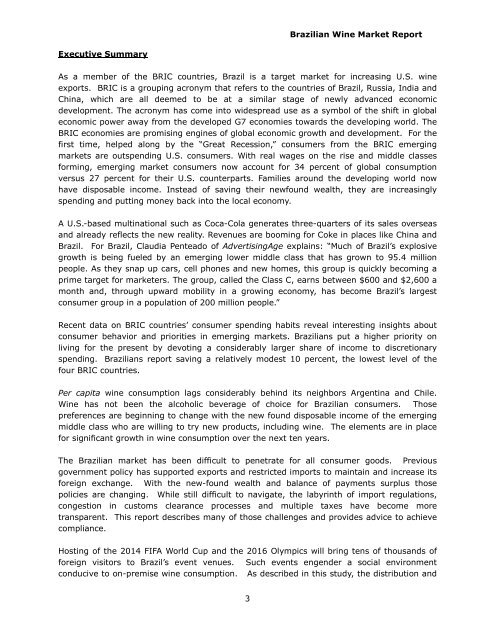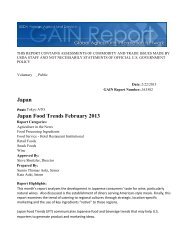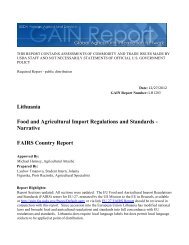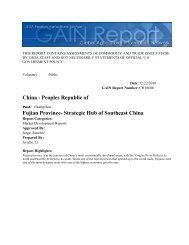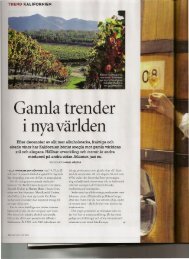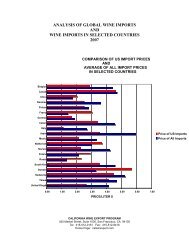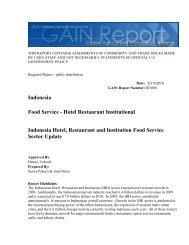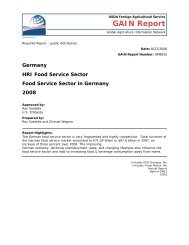Brazil Wine Market Report JBC EMP July 2011 - California Wine ...
Brazil Wine Market Report JBC EMP July 2011 - California Wine ...
Brazil Wine Market Report JBC EMP July 2011 - California Wine ...
Create successful ePaper yourself
Turn your PDF publications into a flip-book with our unique Google optimized e-Paper software.
Executive Summary<br />
3<br />
<strong>Brazil</strong>ian <strong>Wine</strong> <strong>Market</strong> <strong>Report</strong><br />
As a member of the BRIC countries, <strong>Brazil</strong> is a target market for increasing U.S. wine<br />
exports. BRIC is a grouping acronym that refers to the countries of <strong>Brazil</strong>, Russia, India and<br />
China, which are all deemed to be at a similar stage of newly advanced economic<br />
development. The acronym has come into widespread use as a symbol of the shift in global<br />
economic power away from the developed G7 economies towards the developing world. The<br />
BRIC economies are promising engines of global economic growth and development. For the<br />
first time, helped along by the “Great Recession,” consumers from the BRIC emerging<br />
markets are outspending U.S. consumers. With real wages on the rise and middle classes<br />
forming, emerging market consumers now account for 34 percent of global consumption<br />
versus 27 percent for their U.S. counterparts. Families around the developing world now<br />
have disposable income. Instead of saving their newfound wealth, they are increasingly<br />
spending and putting money back into the local economy.<br />
A U.S.-based multinational such as Coca-Cola generates three-quarters of its sales overseas<br />
and already reflects the new reality. Revenues are booming for Coke in places like China and<br />
<strong>Brazil</strong>. For <strong>Brazil</strong>, Claudia Penteado of AdvertisingAge explains: “Much of <strong>Brazil</strong>’s explosive<br />
growth is being fueled by an emerging lower middle class that has grown to 95.4 million<br />
people. As they snap up cars, cell phones and new homes, this group is quickly becoming a<br />
prime target for marketers. The group, called the Class C, earns between $600 and $2,600 a<br />
month and, through upward mobility in a growing economy, has become <strong>Brazil</strong>’s largest<br />
consumer group in a population of 200 million people.”<br />
Recent data on BRIC countries’ consumer spending habits reveal interesting insights about<br />
consumer behavior and priorities in emerging markets. <strong>Brazil</strong>ians put a higher priority on<br />
living for the present by devoting a considerably larger share of income to discretionary<br />
spending. <strong>Brazil</strong>ians report saving a relatively modest 10 percent, the lowest level of the<br />
four BRIC countries.<br />
Per capita wine consumption lags considerably behind its neighbors Argentina and Chile.<br />
<strong>Wine</strong> has not been the alcoholic beverage of choice for <strong>Brazil</strong>ian consumers. Those<br />
preferences are beginning to change with the new found disposable income of the emerging<br />
middle class who are willing to try new products, including wine. The elements are in place<br />
for significant growth in wine consumption over the next ten years.<br />
The <strong>Brazil</strong>ian market has been difficult to penetrate for all consumer goods. Previous<br />
government policy has supported exports and restricted imports to maintain and increase its<br />
foreign exchange. With the new-found wealth and balance of payments surplus those<br />
policies are changing. While still difficult to navigate, the labyrinth of import regulations,<br />
congestion in customs clearance processes and multiple taxes have become more<br />
transparent. This report describes many of those challenges and provides advice to achieve<br />
compliance.<br />
Hosting of the 2014 FIFA World Cup and the 2016 Olympics will bring tens of thousands of<br />
foreign visitors to <strong>Brazil</strong>’s event venues. Such events engender a social environment<br />
conducive to on-premise wine consumption. As described in this study, the distribution and


